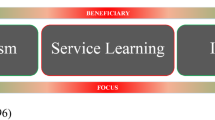Abstract
The impact of quality is measured through various standards in higher educational institutions of India. These standards are evaluated by the higher educational institutions by self evaluation at different levels and it is also assessed by external agencies. Application of different administrative practices have been associated with the quality of higher education. There is lack of quality because all the policies and standards are adopted to the maximum the process of quality achieved is not adequate and permanent. Even-though accreditation provides quality assurance that the academic aims and objectives of the institution are honestly pursued and effectively achieved by the resources available, and the institutions may demonstrate the capabilities of ensuring effectiveness of the educational standards during the validity period, the lack of quality is estimated using structural equation modeling technique. In this paper Impact of quality of some important administrative practices called quality standards such as vision and mission, leadership and governance, faculty recruitment and qualification, infrastructural facility and curriculum adopted and how it is applied is evaluated using SEM model.


Similar content being viewed by others
Abbreviations
- HEI:
-
Higher educational institutions
- SAC:
-
Students as customers
References
Aldridge, S., Rowley, J.: Measuring customer satisfaction in higher education. Qual. Assu. Educ. 6(4), 197–204 (1998)
Athiyaman, A.: Linking student satisfaction and service quality perceptions: the case of university education. Eur. J. Mark. 31(7), 528–540 (1997)
Barrett, P.: Structural equation modelling: adjudging model fit. Personal. Individ. Differ. 42(5), 815–824 (2007)
Brochado, A.: Comparing alternative instruments to measure service quality in higher education. Qual. Assur. Educ. 17(2), 174–190 (2009)
Cheung, A.C.K., Yuen, T.W.W., Yuen, C.Y.M., Cheng, Y.C.: Strategies and policies for Hong Kong’s higher education in Asian markets. Int. J. Educ. Manag. 25(2), 144–163 (2011)
Daire, H., Joseph, C., Michael, R.M.: Structural equation modeling: guidelines for determining model fit. Electron. J. Bus. Res. Methods 6(1), 53–60 (2008)
Finney, T.G., Finney, R.Z.: Are students their universities’ customers? An exploratory study. Educ. Train. 52(4), 276–291 (2010)
Firdaus, A.: The development of HEdPERF: a new measuring instrument of service quality for the higher education sector. Int. J. Consum. Stud. 30(6), 569–581 (2006)
Hair, J.F., Anderson, R.E., Tatham, R.L., Black, W.C.: (1998). Multivariate data analysis. In: Pont, M., McQuilken, L. Testing the Fit of the BANKSERV Model to BANKPERF Data. ANZMAG conference proceedings (2002), pp. 865. Prentice- Hall, Upper Saddle River
Hair, J.F., Anderson, R.E., Tantham, R.L.: (2006a). Multivariate data analysis. 10th edn., Prentice Hall: New Jersey. In: Malek AL- Majali, Nik Kamariah Nik Mat (2011). Modeling the antecedents of internet banking service adoption (IBSA) in Jordan: a structural equation modeling (SEM) approach. J. Internet Bank. Commer. 16(1):8–13
Hair, J.F., Anderson, R.E., Tatham, R.L., Black, W.C., Babin, B.J.: Multivariate Data Analysis, 6th edn, pp. 734–773. Pearson Education, New Delhi (2006b)
Hemsley-Brown, J., Oplatka, I.: Universities in a competitive global marketplace. Int. J. Public Sector Manag. 19(4), 316–338 (2006)
Hu, L.T., Bentler, P.M.: Cutoff criteria for fit indexes in covariance structure analysis: conventional criteria versus new alternatives. Struct. Equc. Model. 6(1), 1–55 (1999)
Kenny, D.A., McCoach, D.B.: Effect of the number of variables on measures of fit in structural equation modeling. Struct. Equc. Model. 10(3), 333–351 (2003)
Maringe, F.: The students as consumer: affordances and constraints in a transforming higher education environment. In: Molesworth, M., Scullion, R., Nixon, E. (eds.) The marketisation of higher education and the student as consumer, pp. 142–154. Taylor & Francis, London (2011)
Marsh, H.W., Hau, K.T., Wen, Z.: In search of golden rules: comment on hypothesis-testing approaches to setting cutoff values for fit indexes and dangers in overgeneralizing Hu and Bentler’s findings. Struct. Equc. Model. 11(3), 320–341 (2004)
Martilla, J.A., James, J.C.: Importance-performance analysis. J. Mark. 41(1), 72–79 (1977)
Moogan, Y.J., Baron, S., Bainbridge, S.: Timings and trade-offs in the marketing of higher education courses: a conjoint approach. Mark. Intell. Plan. 19(3), 179–187 (2001)
Nicolescu, L.: Applying marketing to higher education: scope and limits. Manage. Mark. 4(2), 35–44 (2009)
Nordensvard, J.: The consumer metaphor versus the citizen metaphor: different sets of roles for students. In: Molesworth, M., Scullion, R., Nixon, E. (eds.) The marketization of higher education and the student as consumer, pp. 157–169. Taylor & Francis, London (2011)
Oldfield, B., Baron, S.: Student perceptions of service quality in a UK university business and management faculty. Qual. Assur. Educ. 8(2), 85–95 (2000)
Oliveira–Brochado, A., Marques, R.C.: Comparing alternative instruments to measure service quality in higher education. FEP working papers, No. 258, December 2007. Available from: http://ideas.repes.org/p/por/fepwps/258.html#provider
Parasuraman, A., Zeithaml, V.A., Berry, L.L.: SERVQUAL: a multiple-item scale for measuring consumer perceptions of services quality. J. Retail. 64(1), 12–40 (1988)
Senthilkumar, N., Arulraj, A.: SQM-HEI- determination of service quality measurement of higher education in India. J. Modell. Manag. 6(1), 60–78 (2011)
Wright, S.: Correlation and causation. J. Agric. Res. 20, 557–585 (1921)
Wright, C., O’Neil, M.: Service quality evaluation in the higher education sector: an empirical investigation of students’ perceptions. High. Educ. Res. Dev. 21(1), 23–39 (2002)
Yuan, K.H.: Fit indices versus test statistics. Multivar. Behav. Res. 40(1), 115–148 (2005)
Author information
Authors and Affiliations
Corresponding author
Rights and permissions
About this article
Cite this article
Neelaveni, C., Manimaran, S. Structural equation modeling for analysing the impact of quality of administrative practices in higher educational institutions. Qual Quant 50, 1663–1674 (2016). https://doi.org/10.1007/s11135-015-0227-8
Published:
Issue Date:
DOI: https://doi.org/10.1007/s11135-015-0227-8



